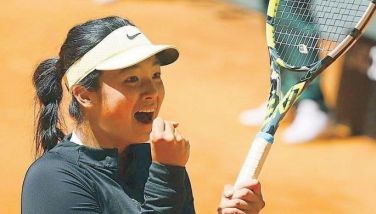Those rare RP golds

October 1, 2002 | 12:00am
Since the first Asian Games in 1951, the Philippines has captured only 53 gold medals in 13 stagings of the quadrennial event often called the Olympics of Asia. That’s an average of four gold medals in each Asiad. So if the country’s contingent of 218 athletes fails to bring home at least four golds from Busan, it will have failed to live up to tradition. The yardstick of success, therefore, starts with four golds.
Philippine sports officials aren’t sticking their necks out to make predictions. Soothsaying is a dangerous thing as it puts unnecessary pressure on athletes in battle and raises sometimes unreasonable expectations from fans. The target that officials are setting is a range of four to 10.
What’s alarming is the Philippines hasn’t collected more than four golds in the last nine Asian Games. It was even blanked from the gold stakes at the seventh Asiad in Tehran in 1974 when only swimmer Ral Rosario bagged silvers in the 100 and 200-meter backstroke.
The tailspin isn’t only alarming. It’s disturbing. At the first Asian Games, the Philippines won five golds, including three from swimming.
Then, when Manila hosted the second edition in 1954, the haul jumped to 14 golds–five from boxing, four each from swimming and shooting, and one from basketball. The harvest dropped to nine golds in 1958 to seven in 1962 to two in 1966 to one in 1970 and to none in 1974.
Four golds were added to the treasure chest in 1978. Then it was down to two in 1982, up to four once more in 1986, down to one in 1990, up to three in 1994, and down to one in 1998.
Boxing has delivered the most golds at 12 but it went zero in 1998. Onyok Velasco, Reynaldo Galido, and Elias Recaido produced the last gold medals from boxing in a rare hattrick at the 12th Asiad in Hiroshima in 1994.
Athletics has contributed 11 golds but alas, the last came from Lydia de Vega in the 100-meter dash at the Seoul Asian Games in 1986–16 years ago. Once dubbed Asia’s fastest woman, she also pocketed a gold in the same event in New Delhi in 1982.
Swimming has collected 10 golds but Billy Wilson was the last tanker to hit paydirt in the 200-meter freestyle in 1982–20 years ago. Philippine Amateur Swimming Association (PASA) secretary-general Ral Rosario, who is in Busan with the country’s team of four male and four female tankers, took a gold in Wilson’s same event in 1978.
Shooting–which has 42 gold medals at stake in Busan–has brought in six golds since Albert von Einsiedel, Martin Gison, Chito Feliciano, and Hernando Castelo broke the ice with a medal apiece in 1954. Alas, the Philippines hasn’t struck gold since Feliciano and Gison repeated in 1958.
Bowling has chipped in five golds, thanks mainly to Bong Coo. For the record, Coo has won the most golds of any Filipino athlete. She began her collection in 1978, bagging the Masters and All-Events and sharing the team of five with Lita de la Rosa, Rosario de Leon, Lily Reformado, and Nellie Castillo. Then, in 1986, Coo won her second straight All-Events and team-of-five golds. No Filipino bowler has earned a gold since Coo’s feat in 1986. In Asian Games history, no left-handed bowler has ever qualified for the finals–leaving four-time World Cup champion Paeng Nepomuceno out in the cold. Will Paeng, a southpaw, finally break the jinx in Busan?
The Philippines dominated basketball in the first four Asian Games. Caloy Loyzaga was the common denominator in those four championship teams. But since 1962, the Philippines has been shut out in the race for gold. The closest the country came to recapturing the gold was in 1990 when coach Robert Jaworski piloted the national team to a silver finish in Beijing. In Bangkok four years ago, coach Tim Cone steered the Philippines to a bronze.
Tennis has produced three gold medals. Raymundo Deyro won the singles title and teamed with Felicisimo Ampon for the doubles gold in 1958. Four years later, Johnny Jose struck gold in the singles. And that was it for tennis. In Busan, tennis is one of eight sports which the Philippines is sitting out–the others are football, handball, hockey, kabaddi, modern pentathlon, rugby, and volleyball. It must be particularly painful for Jose, now the national coach, to see the country beg off from tennis in the Asian Games because of lack of competitive talent.
Golf and billiards have brought in a gold apiece. Parbuster Ramon Brobio did it in 1986 while the tandem of Gandy Valle and Snooky Villanueva snagged the country’s solitary gold four years ago in the 9-ball billiards doubles.
There are 420 golds on the line in Busan. The estimate is about 7,000 athletes from 44 countries are vying for honors. It’s the biggest country representation ever in an Asiad. In 1998, Afghanistan and Saudi Arabia skipped the Asiad to bring down the number of participating countries to 41. In 1994, there were 42 countries in Hiroshima. This year, East Timor was added to the roster as a guest, upping the country list to 44 with 43 regular members in the Olympic Council of Asia.
How many golds will the country’s cast of 218 athletes harvest? Hopes are high that bowling, billiards, and wushu will deliver. Basketball, boxing, karate, taekwondo and golf are also being counted on to produce. In Hiroshima, the Philippines ranked 13th in the medal standings. In Bangkok, the rating dropped to 21st. With 10 golds, the Philippines should be able to crack the top 10 in Busan.
Philippine sports officials aren’t sticking their necks out to make predictions. Soothsaying is a dangerous thing as it puts unnecessary pressure on athletes in battle and raises sometimes unreasonable expectations from fans. The target that officials are setting is a range of four to 10.
What’s alarming is the Philippines hasn’t collected more than four golds in the last nine Asian Games. It was even blanked from the gold stakes at the seventh Asiad in Tehran in 1974 when only swimmer Ral Rosario bagged silvers in the 100 and 200-meter backstroke.
The tailspin isn’t only alarming. It’s disturbing. At the first Asian Games, the Philippines won five golds, including three from swimming.
Then, when Manila hosted the second edition in 1954, the haul jumped to 14 golds–five from boxing, four each from swimming and shooting, and one from basketball. The harvest dropped to nine golds in 1958 to seven in 1962 to two in 1966 to one in 1970 and to none in 1974.
Four golds were added to the treasure chest in 1978. Then it was down to two in 1982, up to four once more in 1986, down to one in 1990, up to three in 1994, and down to one in 1998.
Boxing has delivered the most golds at 12 but it went zero in 1998. Onyok Velasco, Reynaldo Galido, and Elias Recaido produced the last gold medals from boxing in a rare hattrick at the 12th Asiad in Hiroshima in 1994.
Athletics has contributed 11 golds but alas, the last came from Lydia de Vega in the 100-meter dash at the Seoul Asian Games in 1986–16 years ago. Once dubbed Asia’s fastest woman, she also pocketed a gold in the same event in New Delhi in 1982.
Swimming has collected 10 golds but Billy Wilson was the last tanker to hit paydirt in the 200-meter freestyle in 1982–20 years ago. Philippine Amateur Swimming Association (PASA) secretary-general Ral Rosario, who is in Busan with the country’s team of four male and four female tankers, took a gold in Wilson’s same event in 1978.
Shooting–which has 42 gold medals at stake in Busan–has brought in six golds since Albert von Einsiedel, Martin Gison, Chito Feliciano, and Hernando Castelo broke the ice with a medal apiece in 1954. Alas, the Philippines hasn’t struck gold since Feliciano and Gison repeated in 1958.
Bowling has chipped in five golds, thanks mainly to Bong Coo. For the record, Coo has won the most golds of any Filipino athlete. She began her collection in 1978, bagging the Masters and All-Events and sharing the team of five with Lita de la Rosa, Rosario de Leon, Lily Reformado, and Nellie Castillo. Then, in 1986, Coo won her second straight All-Events and team-of-five golds. No Filipino bowler has earned a gold since Coo’s feat in 1986. In Asian Games history, no left-handed bowler has ever qualified for the finals–leaving four-time World Cup champion Paeng Nepomuceno out in the cold. Will Paeng, a southpaw, finally break the jinx in Busan?
The Philippines dominated basketball in the first four Asian Games. Caloy Loyzaga was the common denominator in those four championship teams. But since 1962, the Philippines has been shut out in the race for gold. The closest the country came to recapturing the gold was in 1990 when coach Robert Jaworski piloted the national team to a silver finish in Beijing. In Bangkok four years ago, coach Tim Cone steered the Philippines to a bronze.
Tennis has produced three gold medals. Raymundo Deyro won the singles title and teamed with Felicisimo Ampon for the doubles gold in 1958. Four years later, Johnny Jose struck gold in the singles. And that was it for tennis. In Busan, tennis is one of eight sports which the Philippines is sitting out–the others are football, handball, hockey, kabaddi, modern pentathlon, rugby, and volleyball. It must be particularly painful for Jose, now the national coach, to see the country beg off from tennis in the Asian Games because of lack of competitive talent.
Golf and billiards have brought in a gold apiece. Parbuster Ramon Brobio did it in 1986 while the tandem of Gandy Valle and Snooky Villanueva snagged the country’s solitary gold four years ago in the 9-ball billiards doubles.
There are 420 golds on the line in Busan. The estimate is about 7,000 athletes from 44 countries are vying for honors. It’s the biggest country representation ever in an Asiad. In 1998, Afghanistan and Saudi Arabia skipped the Asiad to bring down the number of participating countries to 41. In 1994, there were 42 countries in Hiroshima. This year, East Timor was added to the roster as a guest, upping the country list to 44 with 43 regular members in the Olympic Council of Asia.
How many golds will the country’s cast of 218 athletes harvest? Hopes are high that bowling, billiards, and wushu will deliver. Basketball, boxing, karate, taekwondo and golf are also being counted on to produce. In Hiroshima, the Philippines ranked 13th in the medal standings. In Bangkok, the rating dropped to 21st. With 10 golds, the Philippines should be able to crack the top 10 in Busan.
BrandSpace Articles
<
>
- Latest
- Trending
Trending
Latest
Trending
Latest
Recommended






























